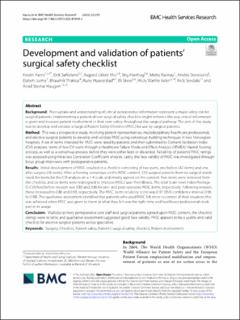| dc.contributor.author | Harris, Kristin | |
| dc.contributor.author | Softeland, Eirik | |
| dc.contributor.author | Moi, Asgjerd Litleré | |
| dc.contributor.author | Harthug, Stig | |
| dc.contributor.author | Ravnøy, Mette | |
| dc.contributor.author | Storesund, Anette | |
| dc.contributor.author | Jurmy, Elaheh | |
| dc.contributor.author | Thakkar, Bhaumik | |
| dc.contributor.author | Haaverstad, Rune | |
| dc.contributor.author | Sevdalis, Nick | |
| dc.contributor.author | Haugen, Arvid Steinar | |
| dc.coverage.spatial | Norway | en_US |
| dc.date.accessioned | 2022-06-03T09:08:46Z | |
| dc.date.available | 2022-06-03T09:08:46Z | |
| dc.date.created | 2022-03-14T21:41:08Z | |
| dc.date.issued | 2022 | |
| dc.identifier.citation | Harris, K., Søfteland, E., Moi, A. L., Harthug, S., Ravnøy, M., Storesund, A., Jurmy, E., Thakkar, B., Haaverstad, R., Skeie, E., Valen, H. W., Sevdalis, N., & Haugen, A. S. (2022). Development and validation of patients’ surgical safety checklist. BMC Health Services Research, 22(1). | en_US |
| dc.identifier.issn | 1472-6963 | |
| dc.identifier.uri | https://hdl.handle.net/11250/2997468 | |
| dc.description.abstract | Background
Poor uptake and understanding of critical perioperative information represent a major safety risk for surgical patients. Implementing a patient-driven surgical safety checklist might enhance the way critical information is given and increase patient involvement in their own safety throughout the surgical pathway. The aim of this study was to develop and validate a Surgical Patient Safety Checklist (PASC) for use by surgical patients.
Method
This was a prospective study, involving patient representatives, multidisciplinary healthcare professionals and elective surgical patients to develop and validate PASC using consensus-building techniques in two Norwegian hospitals. A set of items intended for PASC were rated by patients and then submitted to Content Validation Index (CVI) analyses. Items of low CVI went through a Healthcare Failure Mode and Effect Analysis (HFMEA) Hazard Scoring process, as well as a consensus process before they were either kept or discarded. Reliability of patients’ PASC ratings was assessed using Intraclass Correlation Coefficient analysis. Lastly, the face validity of PASC was investigated through focus group interviews with postoperative patients.
Results
Initial development of PASC resulted in a checklist consisting of two parts, one before (32 items) and one after surgery (26 items). After achieving consensus on the PASC content, 215 surgical patients from six surgical wards rated the items for the CVI analysis on a 1-4 scale and mostly agreed on the content. Five items were removed from the checklist, and six items were redesigned to improve PASCs’ user-friendliness. The total Scale-level index/Average (S-CVI/Ave) before revision was 0.83 and 0.86 for pre- and post-operative PASC items, respectively. Following revision, these increased to 0.86 and 0.93, respectively. The PASC items reliability score was 0.97 (95% confidence interval 0.96 to 0.98). The qualitative assessment identified that patients who used PASC felt more in control of their situation; this was achieved when PASC was given to them at what they felt was the right time and healthcare professionals took part in its usage.
Conclusion
Multidisciplinary perioperative care staff and surgical patients agreed upon PASC content, the checklist ratings were reliable, and qualitative assessment suggested good face validity. PASC appears to be a usable and valid checklist for elective surgical patients across specialties. | en_US |
| dc.language.iso | eng | en_US |
| dc.publisher | BioMed Central | en_US |
| dc.rights | Navngivelse 4.0 Internasjonal | * |
| dc.rights.uri | http://creativecommons.org/licenses/by/4.0/deed.no | * |
| dc.subject | surgery | en_US |
| dc.subject | checklist | en_US |
| dc.subject | patient safety | en_US |
| dc.subject | patient’s surgical safety checklist | en_US |
| dc.subject | patient involvement | en_US |
| dc.title | Development and validation of patients' surgical safety checklist | en_US |
| dc.title.alternative | Development and validation of patients' surgical safety checklist | en_US |
| dc.type | Peer reviewed | en_US |
| dc.type | Journal article | en_US |
| dc.description.version | publishedVersion | en_US |
| dc.rights.holder | © The Author(s) 2022 | en_US |
| dc.source.pagenumber | 12 | en_US |
| dc.source.volume | 22 | en_US |
| dc.source.journal | BMC Health Services Research | en_US |
| dc.source.issue | 259 | en_US |
| dc.identifier.doi | 10.1186/s12913-022-07470-z | |
| dc.identifier.cristin | 2009782 | |
| cristin.ispublished | true | |
| cristin.fulltext | original | |
| cristin.qualitycode | 2 | |

